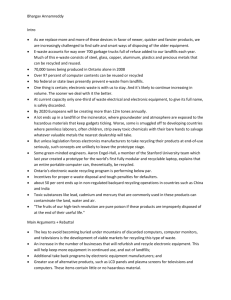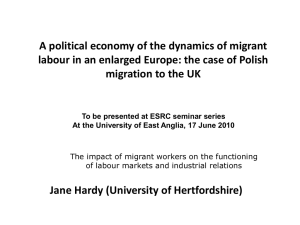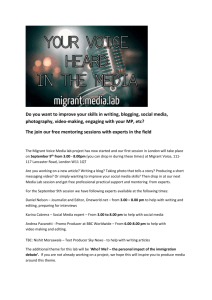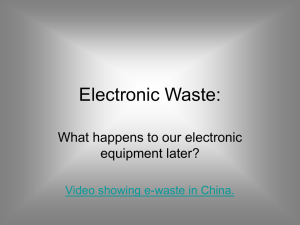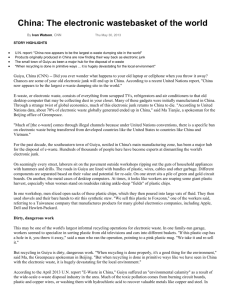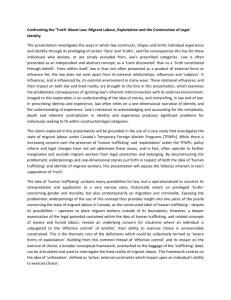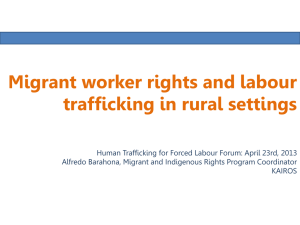CHINA CASE STUDIES - IBGeography
advertisement
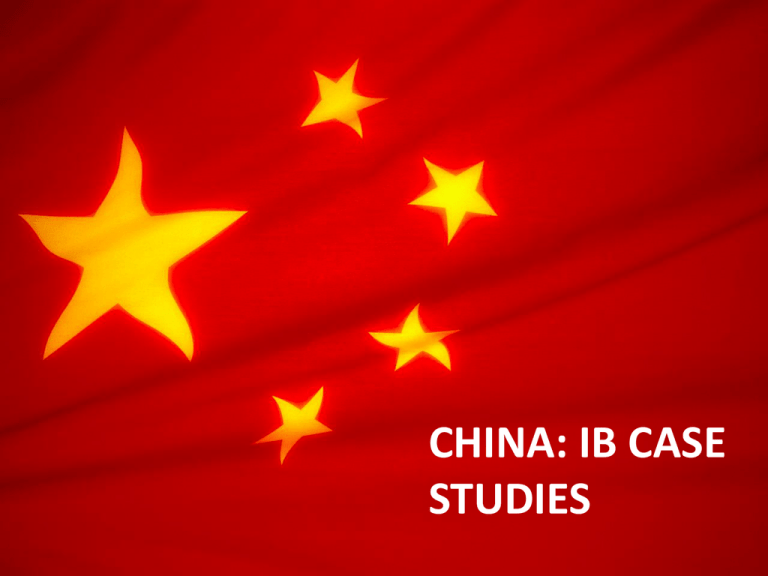
CHINA: IB CASE STUDIES ANTINATAL POLICY In 1979 they introduced a policy requiring couples from China's ethnic Han majority to have only one child (the law has largely exempted ethnic minorities). It has remained virtually the same ever since The goal of this policy was to keep China's population below 1.3 billion by the year 2000. (it is presently 1.2 billion). A spokesperson of the Committee on the OneChild Policy has said that approximately 35.9% of China's population is currently subject to the one-child restriction Contraception is widely practiced throughout China in order to reduce pregnancies and widen the spacing between births. In many While the one child policy is widely carried out cases the so-called one-child policy can be best in China's cities, it has been more flexibly stated today as "One is best, two at most, but enforced in rural areas and in those portions of never a third." the country heavily populated by ethnic China has the largest discrepancy in boy to girl minority groups. ratio worldwide. Whilst the natural ratio is According to some media outlets, around 100 105-100, China has a ratio of over 120-100. million girls have not been born due to a policy that causes many parents to prefer male After rumors that the policy would end soon, children. the current government, lead by president Hu factories have reported youth-labor shortages Jintao, recently announced that it will in fact in recent years, a problem that will only get remain in its current form until at least 2015, worse. In 2007 there were six adults of and possibly for longer. working age for every retiree, but by 2040 that Human trafficking has begun and has the ratio is expected to drop to 2 to 1. Analysts potential to increase as there are less and less fear that with too few children to care for women that men can potentially marry. them. POPULATION IN TRANSITION: AGEING POPULATION Chinese women are having fewer children, but having a smaller generation follow a boom generation - and longer life expectancies means that by 2050, it is expected that for every 100 people aged 20-64, there will be 45 people aged over 65, compared with about 15 today. Only children from single-child parents face what is known as the 4-2-1 phenomenon: when the child reaches working age, he or she could have to care for two parents and four grandparents in retirement. According to government figures, at the end of 2011, when the total Chinese population reached 1.34 billion, 13.7% of the population were 60 or over - that's 185 million people. China's unprecedented demographic transformation has been mainly caused by a significant increase in the country's life expectancy. People are living longer life thanks to significant improvements in living standards, Professor Cai Fang, a Chinese labour economist, estimates that the rapid decrease including improved nutrition, access to of the labour force will lower China's annual education and medical care. growth rate by 1.5 percentage points from now Life expectancy in China today rivals that in the to 2015, and it will decrease a further West - it is one of this country's impressive percentage point during the period from 2016advances. Except China has not yet built a 2020. social safety net to provide pensions, affordable healthcare or homes for all its It's ageing population has been described as elderly. like a fast-approaching tsunami. But China there are six workers paying taxes for each retiree - in 20 years' time, there will be just two workers for every pensioner. appears ill-prepared for the scale and cost of what is to come. POPULATIONS IN TRANSITION: INTERNAL MIGRATION In 2011 a total of 252.7 million migrant workers (an increase of 4.4% compared to 2010) existed in China. Out of these, migrant workers who left their hometown and worked in other provinces accounted for 158.63 million (an increase of 3.4% compared to 2010) and migrant workers who worked within their home provinces reached 94.15 million (an increase of 5.9% compared to 2010). Costs: Increased environmental degradation and pollution, Travelling costs a lot of money when compared to Chinese average income. Overpopulation in municipalities and sub provincial cities, Development of migrant suburbs with no access to local health care, education, workplace protection, Depopulation of rural regions as breadwinners go into the prosperous region, Increased crime and safety issues, Increased demand for resources such as water, electricity and sanitation China's government influences the pattern of urbanization through the Hukou permanent residence registration system, land-sale policies, infrastructure investment and the incentives offered to local government officials. Benefits: Increased supply of labour in urban areas, Increased income for the poor, Poverty reduction, Access to education opportunities for migrant workers, Access to diverse labour market for migrant workers, Migration can be a fun trip with many dangers along the way, like an adventure. Increased income remittance of Migrants to their families in rural regions. Migrant workers access to higher standards of living. Increase of new knowledge and skills for migrants, Migrant workers increase the local population creating demand for services Causes of Migration Poverty, Employment, Education, Religion, Regime, Standard of Living, Economic or Industrial Policies, Special Economic Zones / Sub Provincial Cities, political fears GLOBAL INTERACTIONS: FINANCIAL FLOWS WEALTH & DISPARITIES: AID, FDI & TRADE China has committed $75bn (£48bn) on aid and development projects in Africa in the past decade, according to research which reveals the scale of what some have called Beijing's escalating soft power "charm offensive" to secure political and economic clout on the continent. dragon-slayers emphasize China’s selfish quest for African natural resources and how it sabotages international efforts to keep unpalatable African regimes in check. On the other hand, panda-huggers applaud China’s contribution to Africa’s economic development through infrastructure projects and revenue creation. US researchers have launched the largest public database of Chinese development finance in Africa , detailing almost 1,700 projects in 50 countries between 2000 and 2011. China has also sent thousands of doctors and teachers to work in Africa, welcomed many more students to learn in China or in Chinese language classes abroad and rolled out a continent-wide network of sports stadiums and concert halls. Xi reconfirmed China’s commitment to provide another $20 billion in financing to Africa. China usually attaches a significant amount of such funding to infrastructure projects, which forms the foundation for Africa’s industrialization and economic development. Renewing an offer of US$20 billion (Dh73.4bn) of loans to Africa between 2013 and 2015, Mr Xi pledged to "help African countries turn resource endowment into development strength and achieve independent and sustainable development”. Electronic waste, e-waste, e-scrap, or waste electrical and electronic equipment (WEEE) describes discarded electrical or electronic devices. China already produces about 2.3 million tons (2010 estimate) domestically, second only to the United States. And, despite having banned e-waste imports, China remains a major ewaste dumping ground for developed countries. 82% of the Guiyu children had blood/lead levels of more than 100. Anything above that figure is considered unsafe by international health experts. The average reading for the group was 149. Six of the many villages in Guiyu specialize in circuit-board disassembly, seven in plastics and metals reprocessing, and two in wire and cable disassembly. About a year ago the environmental group Greenpeace sampled dust, soil, river sediment and groundwater in Guiyu where e-waste recycling is done. They found soaring levels of toxic heavy metals and organic contaminants in both places. UNEP titled, "Recycling - from E-Waste to Resources," the amount of e-waste being produced - including mobile phones and computers - could rise by as much as 500 percent over the next decade in some countries Guiyu in the Shantou region of China is a huge electronic waste processing area.[14][19][20] It is often referred to as the “e-waste capital of the world.” The city employs over 150,000 ewaste workers that work through 16-hour days dis-assembling old computers and recapturing whatever metals and parts they can re-use or sell Airborne dioxins one type found at 100 times levels previously measured. Levels of carcinogens in duck ponds & rice paddies exceeded international standards for agricultural areas & cadmium, copper, nickel, & lead levels in rice paddies were above international standards. Heavy metals found in road dust – lead over 300 times that of a control village’s road dust & copper over 100 times



